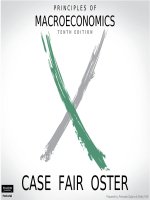Management by hitt back porter CH07
Bạn đang xem bản rút gọn của tài liệu. Xem và tải ngay bản đầy đủ của tài liệu tại đây (573.26 KB, 38 trang )
Chapter 7
Organizational
Structure and
Design
PowerPoint slides by
R. Dennis Middlemist
Colorado State University
Learning Objectives
After studying this chapter, you should be
able to:
2
Explain the concepts of organizational structure and
design.
Explain the concepts of differentiation and
integration and their role in organizational structure
and design.
©2005
Learning Objectives
After studying this chapter, you should be
able to:
3
Describe mechanisms used to achieve
differentiation and integration and balance these
two structural dimensions.
Identify the various structures used by organizations
and describe their strengths and weaknesses.
©2005
Learning Objectives
After studying this chapter, you should be
able to:
4
List the environmental factors that influence
organizational structure.
Determine the appropriate organizational
structure for a firm given a set of internal and
external factors.
©2005
Principles of Organizational
Structure
Organizational structure
The sum of ways an organization divides its
labor into distinct, coordinated tasks
Organizational design
Assessing the organization’s strategy and
environmental demands
Determining the appropriate organizational
structure
5
©2005
Principles of Organizational
Structure
Organizational charts
Illustration of relationships
Units
Lines of authority among supervisors and
subordinates
Illustrated by use of labeled boxes and
connecting lines
6
©2005
Suncor Energy
Organizational Structure
CEO
Executive Vice
President
Oil Sands
7
©2005
Executive Vice
President
Marketing and
Refining
Executive Vice
President
Natural Gas and
Alternative Energy
Senior Vice
President
Major Projects
Adapted from Exhibit 7.1: Suncor Energy Organizational Structure
Differentiation
Differentiation
Division of tasks into subtasks that
are performed by individuals with
specialized skills
Task differentiation
Cognitive differentiation
8
©2005
Integration
Integration
Facilitation of cooperation and interaction of
various parts of the organization
Interdependence
Pooled
Sequential
Reciprocal
9
©2005
Appropriateness of Rules,
Goals, Values
Level of Appropriateness
High
Low
Low
High
Level of Interdependence
Level of Uncertainty
10
©2005
Adapted from Exhibit 7.2: Appropriateness of Rules, Goals, Values
Formalization
Formalization
the official and defined structures and
systems in decision making, communication,
and control in an organization
Line
of authority
Unity of command
Span of control
11
©2005
Factors that Influence the
Span of Control
Job complexity—Jobs that are complicated require more
managerial input and involvement and thus the span of control
tends to be narrower.
Job similarity—If one manages a group of employees performing
similar jobs, the span of control can be considerably wider than if
the jobs of subordinates are substantially different.
Geographic proximity of supervised employees—Because
employees who work in one location are more easily supervised
than employees in dispersed locations, physical proximity to
employees tends to allow a wider span of control.
Amount of coordination—A narrower span of control is
advisable in firms where management expends much time
coordinating tasks performed by subordinates.
12
©2005
Adapted from Exhibit 7.3: Factors that Influence the Span of Control
Factors that Influence the
Span of Control
Abilities of employees—Supervisors who manage employees
who are more knowledgeable and capable can have a wider span
of control than supervisors managing less knowledgeable and
capable employees. The greater the abilities of employees, the
less managerial inputs are required and thus a wider span of
control is possible.
Degree of employee empowerment—Because employees who
are trusted and empowered to make decisions need less
supervision than employees with less autonomy and decisionmaking discretion, supervisors who empower their employees can
have a wider span of control.
Ability of management—More capable managers can manage
more employees than less competent managers. The abilities of
managers to educate employees and effectively respond to their
questions lessen the need for a narrow span of control.
13
©2005
Adapted from Exhibit 7.3: Factors that Influence the Span of Control
Factors that Influence the
Span of Control
Technology—Communication technology, such as mobile
phones, fax, e-mail, workshare software, can allow managers to
effectively supervise employees who are not geographically
proximate, have complex and different jobs, and require significant
coordination.
14
©2005
Adapted from Exhibit 7.3: Factors that Influence the Span of Control
Exhibit Tall and Flat
Organizational Structures
Tall Organizational Structure
Levels = 4
Span of Control = 3
Total Employees = 40
15
©2005
Adapted from Exhibit 7.4: Tall and Flat Organization Structures
Exhibit Tall and Flat
Organizational Structures
Flat
Structure
Tall Organizational Structure
Levels = 3
Span of Control = 7
Total Employees = 57
16
©2005
Adapted from Exhibit 7.4: Tall and Flat Organization Structures
Informalization
Informal organization
Unofficial but influential means of
Communication
Decision making
Control
17
©2005
Centralization and
Decentralization
Centralized organizations
Restrict decision making to fewer individuals,
usually at the top of the organization
Decentralized organizations
Tend to push decision-making authority
down to the lowest level possible
18
©2005
Combinations of Formal/Informal
and Centralized/Decentralized
Formal
Informal
19
©2005
U. S. Military
Philips
Electronics
Mitsubishi
Club Med
Centralized
Decentralized
Adapted from Exhibit 7.5: Combinations of Formal/Informal and Centralized/Decentralized
Functional Structure
CEO
Vice President
Marketing
20
Vice President
Sales
Vice President
Manufacturing
Market research
East region
Purchasing
Recruiting
Advertising
South region
Operations
Training
Promotion
West region
Logistics
Compensation
©2005
Vice President
Human Resources
Adapted from Exhibit 7.6: Functional Structure
Functional Structure
Strengths
Small to medium-sized
firms with limited product
diversification
Specialization of
functional knowledge
Less duplication of
functional resources
Facilitates coordination
within functional areas
21
©2005
Weaknesses
Weak coordination across
functional groups
Restricted view of overall
organizational goals
Limits customer attention
Slower response to
market changes
Burdens chief executives
with decisions
Product Structure
CEO
Vice President
Product A
22
Vice President
Product B
Vice President
Product C
Vice President
Product D
Marketing
Marketing
Marketing
Marketing
Operations
Operations
Operations
Operations
Sales
Sales
Sales
Sales
©2005
Adapted from Exhibit 7.7: Product Structure
Product Structure
Strengths
More focus on products
and customers
Easier to evaluate
performance of the
product
Product responsiveness
to market changes
Less burden on the top
executive in making
operating decisions
23
©2005
Weaknesses
Duplication and lack of
economies of scale
Problems for customers
purchasing across
multiple product groups
Conflicts between
product group and
corporate objectives
Conflict between product
groups
Division Structure
CEO
Vice President
Medical systems
24
©2005
Vice President
Bioscience
Vice President
Clinical
Anesthesia
Labware
Vacutainer
Hypodermic
Cell biology
Diagnostics
Infusion
Immunology
Consulting
Adapted from Exhibit 7.8: Division Structure
Division Structure
Strengths
Reduced functional
duplication
Customer focus can
increase
Cross-product
coordination is eased
Cross-regional
coordination is often
eased
25
©2005
Weaknesses
Most appropriate only for
diversified, large
companies with many
products and product
families
May inhibit cross-division
coordination
Coordination difficulties
between division and
corporate objectives









